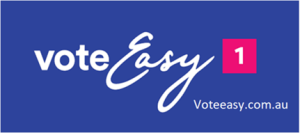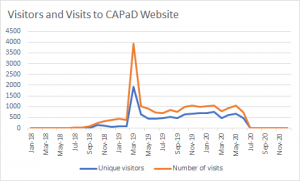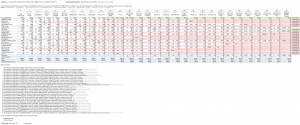
We live in a representative democracy. One power we have is choosing who we elect to represent us.
At elections, it is up to us to select the candidates who we think are best qualified for the job.
CAPaD invites you to ask each candidate to tell you, at every election, why they are qualified to represent you, how they will strengthen democracy and how they are going to work for your electorate's interests.
You will find links to each election's page in the relevant tab below.
Assisting voters - who helps voters decide?
| The organisations and sites listed here all offer candidates a place to share information about themselves, in addition to their party and personal websites and Facebook (and other social media) pages.
They offer voters a place to find out about their candidates (a sort of one-stop-shop for voters). |
 CAPaD is a community supporter of Vote Easy, a non-partisan platform designed for candidates to share information with voters. Like Vote Easy, CAPaD believes an informed voter will make good choices. CAPaD is a community supporter of Vote Easy, a non-partisan platform designed for candidates to share information with voters. Like Vote Easy, CAPaD believes an informed voter will make good choices.
Elections ACT legislated candidate information statements. ABC Vote Compass is a tool developed by political scientists to help you explore how your views align with the major parties. Usually federal elections. For a more complete list of organisations, please see Sites helping voters get to know their MPs and candidates better at our Resources Hub. |
Democracy in Action Conversations
We recognise that who you vote for is your choice.
This year we want the ACT community to help us define how we know our MLAs are doing a good job for the community. Then we want to apply this to help you develop criteria to help you choose how to preference the candidates who you vote for on October 19th.
Conversation 1 on 12th May - completed
We asked:
- What’s a representative?
- What qualities are we seeking in our MLAs?
- How can we know our MLA is working well for the community?
Outputs from Conversation 1
Democracy in Action Collective Statements from Conversation One
Democracy in Action Conversation 1 full report with attachments
Democracy in Action Conversation 1 Outputs summary
Other groups have reached similar conclusions:
Active Democracy Bean Listening Report
These ideas and thoughts fed into -
Conversation 2 on June30, St James Hall, Curtin
Beyond promises and policy: picking good candidates - completed
How can we know which candidate will be a 'good' representative?
We explored:
Given the attributes for MLAs coming from conversation 1:
1.How can we know confidently that candidates have demonstrated these in their previous practice?
2.How do we expect candidates to balance their responsibilities to their party or group with their responsibilities to their electorate community?
3.How can we find out that the party/group/personal platforms and promises are consistent with community needs and are prioritised for the community’s benefit?
4.Where do we find out the information we want to know about candidates?
The Collective Statements from this conversation are here. They will feed into -
Conversation 3 – Know your Candidate forums in late September
- How do the candidates wanting your vote plan to represent you?
- How are they going to hear their community’s voice?
- How will they involve us, the people, in policy and program planning decisions?
Dates and Venues
Brindabella – Tuggeranong Community Centre Hall; Sunday 29 September– 2.00-4.00pm
Murrumbidgee – St James Uniting Church, Curtin; Sunday 22 September– 2.00-4.00pm
Ginninderra – Belconnen Community Centre Monday; 23 September– 7.00-9.00 pm
Kurrajong – Currie Crescent Community Hall, Kingston; Tuesday 24 September– 7.30-9.00 pm
Yerrabi – tba
Spread the word please. Voting is one of our citizen powers and knowing your candidates is crucial to knowing who to preference.
We will regularly update this page as the activities are planned in more detail.
ACT Government
The Legislative Assembly (the Assembly) is the ACT's parliament. There are 25 Members of the Legislative Assembly (MLAs).
The ACT has five electorates: Yerrabi, Ginninderra, Kurrajong, Murrumbidgee and Brindabella. Five MLAs represent each electorate.
Find out which electorate you are in here.
ACT Assembly elections happen every four years on the third Saturday of October. This year, 2024, that is October 19th.
ACT Voting made easy
Voting
Vote for at least the number of candidates as there are positions available.
A vote is a number in a box on the ballot paper (no ticks, no crosses, no other marks). At present for ACT electorates there are five positions available.
Put at least a number 1.
Your vote will be counted up to the point you stop numbering.
Ideally, to make sure the people you want elected are elected, number every square.
How votes are counted
Under the ACT’s Hare-Clarke voting system (see here for more detail) we elect five MLAs for each of the five electorates to the ACT Assembly.
Candidates are elected if they achieve a certain proportion of the vote (called a quota). Candidates who reach the quota are elected and have the rest of their preferences distributed among the other candidates in the order that each voter has put them on the ballot paper.
Candidates who don’t reach a quota are eliminated from the count after each round of counting, starting with the person with the least votes at that stage.
This continues until five MLAs are elected for each electorate.
Our 2022 election page with advice and suggestion to help you make an informed vote is here.
You can find the report against our education campaign here.
This figure, courtesy of Lee Yingtong Li (right click & open in new tab/window to enlarge and scroll) shows the preference flows for the second ACT senate seat. It confirms the importance of numbering every square on the senate ballot. Preference flows matter.
2019 Federal election
The 2019 Federal election showed us that a Federal election presents a different level of organisation compared to an ACT election. The issues are different and the number of candidates across House of Representatives and the Senate makes it a much larger exercise. All major party and most other minor party and independent candidates ignored our requests for candidate statements.
Our website traffic however increased: visitors grew to nearly 2000 from less than 100, and visits went from under 500 to 4000 during May 2019. So some one was interested in our candidate statements.
This comprised about 1460 views of candidate statements, as well as 337 reviews of the 2016 Federal election and 581 views of the 2016 ACT election pages.
2016 ACT Election Candidate Statement Exercise
The 2016 ACT Election is the first election that the Alliance attempted this type of exercise. It provided a valuable learning exercise for the Alliance in how to run such a process, and the importance of giving people the chance to know more about their candidates, separately to their Party platforms.
ACT Elections 2016 Document Downloads
- At-a-glance analysis of the Candidate Statement Exercise: numbers and information.
- Candidate Statements by the successful candidates (those becoming MLAs). Note this is one large document with the MLAs arranged in electorate. There is a table of contents.
- Candidate Statements by the unsuccessful candidates - are not available.
- CAPaD Policy and Role regarding the 2016 Federal and ACT Elections
- Media Release: Candidate Statements the "New Normal"?
- Candidates who provided a statement
- Candidates who did not provide a statement
- Map of Electoral Boundaries
- Comment and reflection of the ACT 2016 Elections : CAPaD's candidate statements were well-received by the candidates and by the public.
Statement of non-partisanship
The Canberra Alliance for Participatory Democracy (CAPaD):
- Is strictly non-partisan in electoral matters;
- Does not support nor endorse any political party, their candidates or independents;
- Is committed to facilitating community participation in the political system including informed engagement in elections;
- Will share information about events and materials that invite community level participation but not formal campaign, Party or individual candidate material.
Authorised by Peter Tait, Canberra Alliance for Participatory Democracy.

